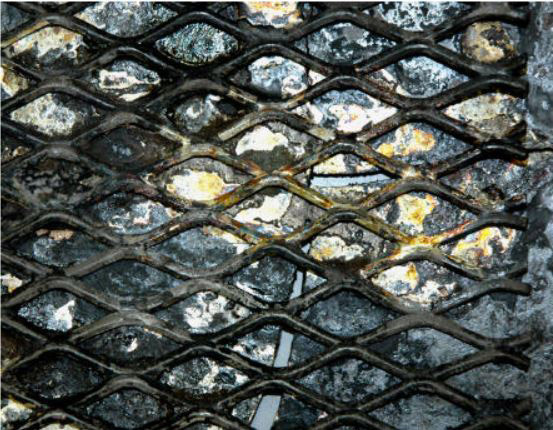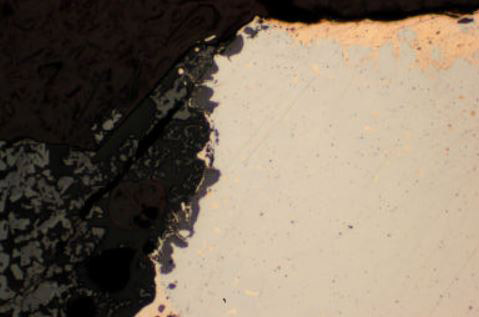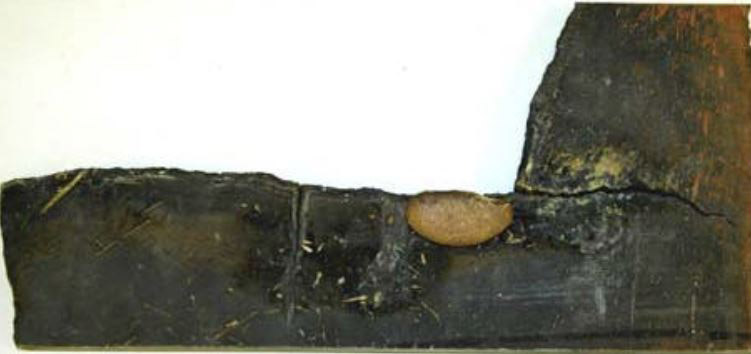MOLTEN METALS
From time to time one or another heat resistant alloy is used in contact with a low melting point metal in its molten state. Depending upon which metals are involved, the temperature and the state of stress, that molten metal may dissolve, or may crack, the heat resistant alloy.
Nickel — with respect to nickel – chromium – iron or nickel – chromium alloys, the higher the nickel content, the more rapidly the solid metal dissolves in the molten. As a ROUGH rule of thumb, where contact with low melting metals is concerned the lower nickel alloys, or even the ferritic stainlesses, are preferred. High nickel alloys, such as RA600 (76%Ni) tend to be attacked more severely.
Molybdenum — in resisting corrosion by molten zinc alloys, a molybdenum addition appears to benefit austenitic stainless or nickel alloys. One example is 316L, which at 2% Mo seems to work better than does 304, in contact with molten zinc for galvanizing or die casting operations. AL-6XN® alloy, 6.3% Mo, has performed better than 316L at 1000°F (538°C) in 26% aluminum, 7% lead, 67% zinc. Alloy C-276, 15% Mo, has been used in continuous zinc galvanizing at about 850°F (454°C).
Dissimilar Metals — must not be used in contact with molten metals. A phenomenum known as mass transfer1 may dissolve the higher nickel alloy preferentially. One example known to us was a lead pot fabricated of heavy RA330 alloy plate. It had been welded with the 72% nickel 19% chromium 2.7% columbium (niobium) weld filler 82, ERNiCr-3. It failed when the weld bead separated from the base metal. Analysis of the weld bead showed that it was now a lead alloy, with about 5% columbium (niobium) and traces of chromium and nickel.
Embrittlement — liquid metal embrittlement may occur just below the melting point of the low melting metal. The same molten metal may either dissolve or crack2 the heat resisting alloy, depending upon the stress level, and how much molten metal is present.
Aluminum — molten aluminum dissolves any Fe, Fe-Cr, Ni-Cr-Fe or Ni-Cr alloy, likewise for the cobalt alloys. Nevertheless, bar of alloys such as RA446 (25% Cr, balance Fe) has been used for stoppers in bottom pour aluminum ladles. Life is erratic, depending upon how long it takes the aluminum to reduce and/or wash away the hot rolling scale from the bar. RA330 (35%Ni 19%Cr 1.2%Si balance Fe) 11 gage/3mm wall cooling tubes have been used in an aluminum melting furnace, right above the metal. Wherever molten aluminum splashes on the RA330 it goes right through it like hot water through snow. Titanium tubing has been used to siphon molten aluminum. That it has been successful at all is due entirely to the tenacious oxide film on the titanium.
Antimony — we have no definite experience. There are indications that lead baths which have been contaminated by antimony, from using scrap lead, are corrosive to Ni-Cr-Fe alloys.
Bismuth — To satisfy OSHA, one American file manufacturer switched from molten lead to bismuth in its 1450°F (788°C) austenitizing baths. The lead, now bismuth, pots are fabricated of RA330 plate welded with RA330-04 (35%Ni 19%Cr %Si 5%Mn 0.25%C) weld filler. These pots have two loops of 2” Sch 40 RA330 pipe welded to the bottom. An induction coil fits through the loops and heats the bismuth. When too much heat is applied, the loops are attacked. When maintained at 1450°F (788°C) no problems have been reported to us.
Cadmium — We have no experience with the effects of Cd on austenitic alloys. However cadmium is said to embrittle steel at temperatures as low as 450°F (232°C), which is about 160°F (90°C) below its melting point3.
Calcium — Molten calcium can crack RA330, and presumably higher nickel alloys as well. The example here is from an RA330 retorts used to process ferrites, f or the electronics industry. This is done at high temperature under a hydrogen atmosphere. Calcium carbonate has been used as part of the mix. The hydrogen reduces it to calcium metal. The metallic calcium vapors haven’t been a problem. Down toward the retort base it is cooler, and molten calcium condenses on the retort wall. The retort cracks at this location.

RA330 fracture surface, calcium LME. About 6X. This fracture surface is very similar in appearance to Figure 12, page 60, Volume 10, 8th Edition, Metals Handbook (ASM). That figure illustrates 2024 – T4 aluminum cracked by mercury.
Copper — molten copper and copper base alloys penetrate the grain boundaries of any austenitic iron, nickel – chromium – iron or nickel – chromium alloy. Even carbon steel, austenitized by immersion in molten copper, can have the austenite grain boundaries neatly outlined by copper metal.
Launders for handling molten copper are successfully made of the high chromium ferritic alloy RA446 (25%Cr, balance Fe). Siphons for handling molten copper have been 446 seamless tubing.
Skimmers for removing slag from ladles of molten brass or copper are mild steel, 430 stainless (16.5%Cr, balance Fe) and, more likely, RA446. All of the austenitic alloys will fail rapidly in contact with molten copper or copper alloys.
The old Belgian alloy UMCo – 50, 50%Co 28%Cr 22%Fe, was said to function well in contact with molten copper. We have no experience to confirm this. Haynes® International have made this alloy under their own trade name HS 150.
Molten copper attack is a problem in muffles used for copper brazing steel. Eventually some copper braze spills onto the bottom of the muffle. With an exothermic brazing atmosphere the Ni – Cr – Fe alloy (usually RA330) muffle develops a scale which may be protective enough to prevent small amounts of copper from actually wetting the muffle floor. With enough copper the scale may be penetrated and the muffle attacked. We have seen some 15 pounds of copper, with t he appearance of cast bars, removed from the corrugated bottom of an 11 gage/3mm wall RA333 muffle. One manufacturer reported longer life when RA85H was used for muffle bottoms, rather than RA330 or RA601. This 15% Ni 3.5% Si grade is no longer available. One might consider the 11% nickel — 1.7% silicon alloy RA 253 MA as a replacement. However, bear in mind that all austenitic alloys will eventually fail from molten copper attack.
A dry hydrogen or hydrogen – nitrogen brazing atmosphere does not permit the muffle to develop any protective oxide film. Even small amounts of spilled copper will completely penetrate the nickel alloy floor along the grain boundaries. Hydrogen then escapes through the hole and burns like a torch, locally overheating, and sometimes melting, the surrounding area. One practical solution is a sheet of ferritic stainless such as 409 or 430 on the muffle floor, to keep molten copper from contacting the austenitic alloy muffle.

This RA 253 MA® tray, with RA330® expanded metal, was used to process mining tool bits at 2000°F in air. Excess brass binder melted out and cracked the tray.
Analysis of the yellow metal ranged from 20 to 40% Zn, balance copper. One would expect some amount of zinc to be removed by oxidation in air at this temperature. Life is measured in days. There is no austenitic alloy that will withstand this service. An applied oxide coating, or lining the tray with ferritic stainless are suggested approaches.

Microstructure of cracked area above. Note copper alloy penetration into the RA 253 MA base metal. Grey phase at left is oxide.

RA330 sintering muffle cracked by molten bronze
After five RA330 muffles used for sintering powdered iron had failed, we were asked to look at one of them. Cracks as much as a foot long had developed in the sides. This muffle was intended only for powdered iron sintering. The presence of about an ounce of bronze coming out of this crack indicated that some bronze bearings had inadvertently been sintered in the same muffle. When a few bearings or bearing powder accumulated in the muffle, it melted when it was used for iron parts. Iron is sintered above 2000°F (1150°C), bearing bronze melts perhaps 1850°F (1010°C).
Lead — Molten lead heat treating baths, or lead pans, are fabricated of mild steel, RA309, RA310, RA 253 MA and sometimes RA330. The lead itself isn’t terribly corrosive to these alloys, although the lower nickel grades may be preferable. Alloy 600 is another matter — this high nickel alloy is dissolved by molten lead.
With other alloys it is the lead oxide on the surface that attacks the metal sides severely at the lead – air interface. The molten lead is usually covered with so – called charcoal, more likely sulfur bearing coke of some sort, to reduce lead fumes and oxidation. The lead still oxidizes. Sulfidation and carburization also occur at the lead – air interface, caused by this protective covering.
The most direct approach to this local corrosion is to make the metal wall twice as thick at the lead – air interface.
Pure lead should be used. Antimony, brought in when scrap lead is used, increases attack from the molten metal itself.
Lithium — a vessel fabricated in the 1970’s of RA333 for the US Navy liquid metal embrittled & cracked from residual stress in the formed head, when operated 1650°F (900°C) with molten lithium. Had we been asked, we would have suggested first annealing the head to remove forming stresses. Corrosion of RA333 occurs primarily by selective leaching of the nickel. Alloy X behaves in a similar manner. Based on laboratory tests, TZM molybdenum and pure iron (to 1000°C) are said to have good resistance to molten lithium corrosion. Ferritic stainlesses are said to be subject to chromium leaching. However E – Brite was found more resistant to molten lithium than either nickel or cobalt base alloys. These are laboratory test results, not necessarily confirmed in service.
Magnesium — used in reduction of TiCl 4 is normally contained in mild steel pots, or steel pots lined with 430 stainless. Melting at 1202°F (650°C), magnesium tends to leach the nickel out of Ni – Cr – Fe alloys. Because carbon steel scales on the outside (fireside) of the melting pot, a few experimental clad pots have been tried. These have been either RA 253 MA or RA330 explosively clad to mild steel. The nickel – chromium – iron alloy outside provides high temperature strength and oxidation resistance while the carbon steel inside is more compatible with the molten magnesium.
Rare Earths — the same manufacturer of ferrites who had problems with molten calcium cracking RA330 has also had both cast and fabricated Ni – Cr – Fe alloy grids crack. Deposits on the cast grid analyzed 34% samarium, 10% praseodymium and 1% neodymium. Apparently rare earth compounds used in the manufacture of ferrites were reduced to metallic form by the hydrogen atmosphere. They dripped on the cooler grid at the bottom end of the retort. A lower nickel alloy would probably have been more satisfactory for these grids.
Selenium — In the 1970’s, RA330 was used as 1” (25mm) diameter fabricated tubular heating elements in five 9’s purity selenium and arsenic selenide at 500 and 600°F (260 and 316°C), respectively. No degradation of product purity was reported, nevertheless we urge anyone planning to use RA330 for such an application to run their own test program.
Silver — Silver braze alloys have long been known to crack or dissolve austenitic alloys. Cold worked 300 series stainless steels can not be silver brazed without danger of cracking. One reason is that silver braze, in contrast to copper braze metal, melts well below the annealing or even stress relieving temperature of the austenitic alloy to be brazed. In hydrogen atmosphere braze retorts, molten silver braze alloy dripping on the bottom of an RA330 retort will penetrate this austenitic alloy at the grain boundaries and cause hydrogen leaks.
Solder (lead – tin) — No molten metal attack reported. Temperatures are low, and the chloride fluxes used are more of a corrosive problem than is the solder itself. RA333 alloy has been used in tin can soldering applications, again more to withstand the ammonium chloride flux than the Pb – Sn alloy.
Tin — both RA446 3/16” (4.8mm) plate and RA 253 MA sheet have been used for side shields in the tin float process of plate glass manufacture. Tin at 600°C (1112°F) under hydrogen atmosphere is reported to have dissolved, then re – deposited, 304 stainless steel, and to have pockmarked carbon steel in the same bath, in the process of decontaminating soil.
Zinc — Zinc and zinc alloys are used for both electroplating and hot – dip galvanizing of steel. Zinc, which melts at 787°F (419C°), may liquid metal embrittle steel at temperatures as low as about 7 50°F (400°C)3 . This may occur with both Zn plated bolts and with galvanized structural steel. Molten zinc can either dissolve or liquid metal embrittle austenitic alloys, depending upon specific conditions.
Zinc is the most commonly used low melting meta l which may affect steel or nickel alloys. For this reason, data and applications experience are more broadly available for Zn than for other low melting metals.
Molten zinc and zinc-aluminum alloys are used for galvanizing and die casting. Our observations have been that commercially pure iron, 316L stainless, RA85H, 309, AL – 6XN and alloy C – 276 have all been used in molten zinc/zinc alloy with some degree of success. RA330 is no good at all in molten zinc, and it seems reasonable to assume that the other nickel – chromium – iron alloys such as 800H or 600 are as bad or worse.
Zinc die casting pots have been heated by gas fired immersion tubes fabricated of RA309. The tubes are usually plasma sprayed with zirconia to enhance life, but this coating is subject to damage by mechanical abuse. The 309 weld bead is attacked to a greater degree than the base metal. One failed 309 tube, which had leaked full of zinc die casting alloy, was heated rapidly with an oxyacetylene torch to melt out the zinc. The high thermal stress coupled with zinc wetting the 309 metal inside cracked the tube. The fracture surface was typical of liquid metal embrittlement, i.e., it looked like RA330 cracked by molten calcium or 2024 – T4 aluminum cracked by mercury.
When 1” (25mm) round bars of both RA330 and 316 stainless were both used in the same zinc die cast alloy scrap recovery project the 35% nickel alloy was severely eaten away and chromium was selectively leached out. The 316 bars merely developed a galvanized coating with no appreciable metal loss. Temperature was about 1000°F (540°C).
We observed that one steel company involved in continuous hot – dip galvanizing of sheet made the 850°F (454°C) zinc pot and sink arms of low carbon, low manganese, low silicon nearly pure iron. At the zinc – atmosphere interface the pot was sheathed with 316 stainless steel. The iron sink roll was weld overlaid with 316 stainless, as were the journals. Sleeve bearings, to ride on these 316 overlaid journals, were fabricated of C-276 (UNS No. N10276) sheet. The chute through which the steel sheet passes into the zinc had a tip of C-276 where it entered the molten zinc bath.
We have found definite success with AL-6XN alloy for small sink rolls and bearings for galvanizing wire. Initially the company used 316, then Rolled Alloys convinced them to try RA85H, which was an improvement. On test, AL-6XN looked even better. This was confirmed in service, and for the past 3 or 4 years they have been using AL-6XN. They tried 316 for the trunnion sleeve, over AL-6XN trunnions, and the 316 did not last long. Now AL-6XN is used for both the trunnion and the sleeve bearing, as well as for the sink roll itself.
Rolled Alloys laboratory immersion testing in molten zinc ranked these alloys similar to how they behaved in service:
| 250 hour test in molten zinc, 850°F (454°C) | |||||
|---|---|---|---|---|---|
| alloy | original thickness | average metal loss | metal loss, ratio | ||
| inch | (mm) | inch | (mm) | to AL-6XN® | |
| AL-6XN | 0.120 | (3.05) | 0.0056 | (0.142) | 1.00 |
| 556™ | 0.110 | (2.79) | 0.0034 | (0.086) | 0.6 |
| 1008 | 0.1328 | (3.37) | 0.0104 | (0.264) | 1.9 |
| RA309 | 0.118 | (3.0) | 0.017 | (0.432) | 3.0 |
| RA85H® | 0.1164 | (2.96) | 0.0226 | (0.574) | 4.0 |
| RA446 | 0.2008 | (5.10) | 0.0234 | (0.594) | 4.2 |
| 316 | 0.1188 | (3.02) | 0.044 | (1.12) | 7.9 |
References
- David H. Gurinsky, The Behavior of Materials in Aggressive Liquid Metals, pages 5 – 20, Nuclear Metallurgy, A Symposium on Behavior of Materials in Reactor Environment, February 20, 19 56, Institute of Metals Division, American Institute of Mining and Metallurgical Engineers, New York, New York, U.S.A.
- J.E. Cantwell and R.E. Bryant, How to Avoid Alloy Failures in: 1. Piping by liquid metal attack, 2. Flare tips by seve re cracking, pages 114 – 117, Hydrocarbon Processing, May, 1973
- Semih Genculu, Liquid metal embrttlement — Part I , Materials Performance p65 January 1993, National Association of Corrosion Engineers, Houston, Texas



